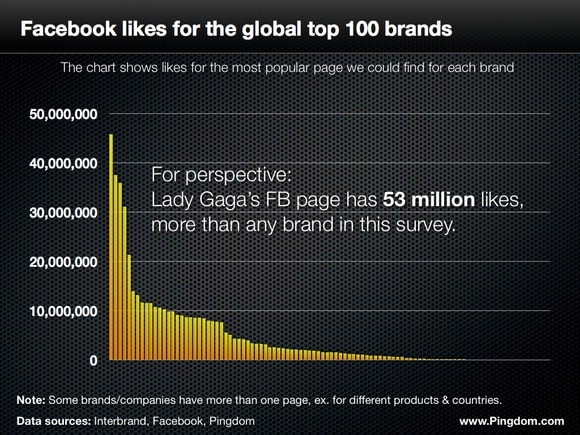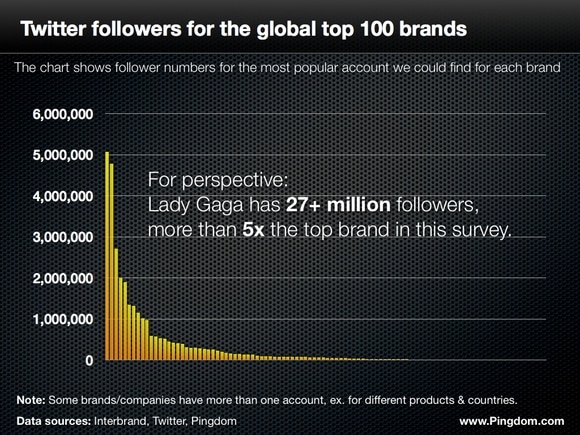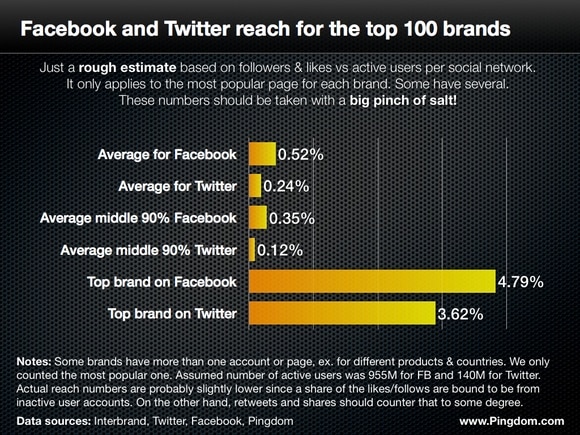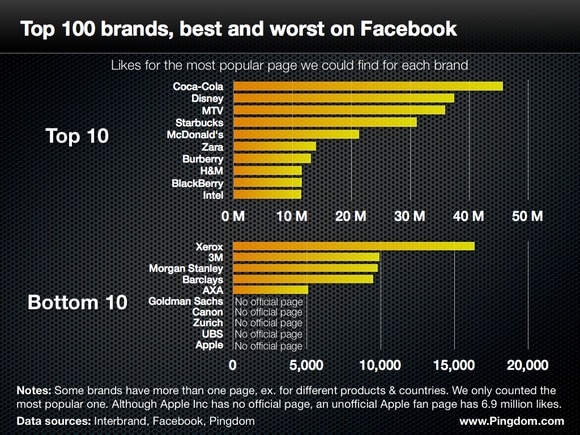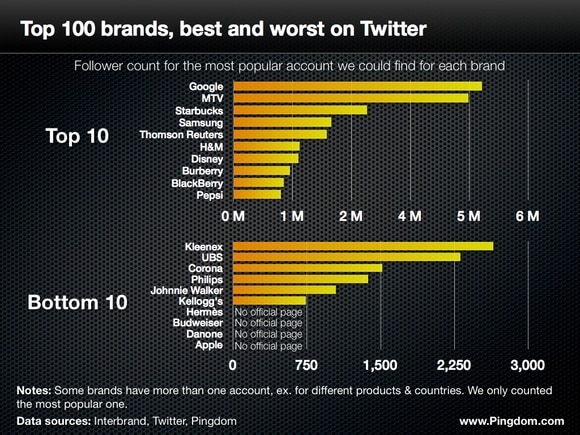
Over the past few years, social networks have become a major communications channel for today’s brands and companies. That’s why it’s surprising to see that even now, in 2012, many of the world’s top brands have a relatively weak presence on both Twitter and Facebook.
For this survey, we started with Interbrand’s Best Global Brands (2011 edition), a list of the world’s top 100 brands. When we refer to “the top brands” in this article, we’re referring to this specific list.
To give you an idea of what kind of list this is, it is made up of the likes of Coca-Cola, IBM, Google, Microsoft, McDonald’s, Toyota, Disney, Intel, Nokia, Apple, H&M, Pepsi, Honda, American Express, Colgate, Nike, Ikea, Canon, Sony, Gucci, Panasonic, Cartier, and so on. Big, corporate brands in other words. The full list is available on Interbrand’s site.
We then tried to find their official accounts on Twitter and official pages on Facebook, and collected the follower numbers and likes. How strong is their official presence on these two social networks?
This is what we found out.
Brand presence on Facebook
Which specific brands have what kind of following is not what this survey is about (although you can view the strongest and weakest later in this article), it’s the general distribution we’re interested in.
Remember that Facebook is a huge social network today. The most recent number is 955 million active users. So a few hundred thousand likes for a worldwide brand page is not that impressive.
With that in mind, we find it notable that 33 of these 100 brands have less than 500,000 likes on their strongest brand page.
A few of these top brands don’t even have an official page at all, most notably Apple. On the other hand, who are we to criticize Apple? They seem to be doing pretty well regardless… Same thing on Twitter, where Apple has no official company account, aside from a few product-specific ones.
By the way, to put these numbers into perspective, there are several artists with pages that have racked up in excess of 50 million likes.
Brand presence on Twitter
While it’s a smaller social network than Facebook, Twitter is still an important place for brands. It has at least 140 million active users today (the number is from earlier this year, and is most likely a bit larger now).
When you consider the massive follower numbers seen by celebrities such as actors and music artists, one might expect at least some of the top brands to come close. But no.
What this shows is that corporate brands on Twitter are definitely nowhere near as successful as “people brands.” Just a quick glance at a list of the most followed accounts on Twitter makes that obvious. There’s barely a corporate brand anywhere in the top 100.
We are quite frankly baffled by how few followers some accounts have. For example, @IBM only has 23k followers. And what about @Gillette? 17k followers. We are talking about huge, global brands here.
In fact, 65 out of 100 of these brands have fewer than 100k followers on Twitter for their most popular account.
Reach on Facebook and Twitter
Since comparing absolute numbers is a bit apples and oranges, Facebook and Twitter are very different in size after all, we have included a very rough “reach” estimate here.
Note that this really is a very speculative estimate. This chart only shows followers divided by active users per social network. There is no way for us to know how many of those followers (or likes on Facebook) are actual active users since there are always more registered accounts than active users. These numbers are most likely a bit high.
The estimated average brand reach is almost twice as large on Facebook as on Twitter. But as we mentioned, these numbers should be taken with a pinch of salt regardless. We included them here to add another interesting data point (followers and likes vs. social network size).
Note also that some companies and brands have spread out their presence over multiple pages, for example for different countries or products. These are not fairly represented in this survey. That said, there’s usually one pretty dominant account or page per brand.
The best and the worst
Since you are probably wondering which specific brands did the best (and worst) in this survey, here you go. These are the top and bottom of the 100 brands included in Interbrand’s Best Global Brands list, based on what we could find.
Sure, some types of brands will have an easier time getting a following than others. After all, a bank or insurance company will have a hard time in a popularity contest with a large clothing brand. Still, many brands we expected would be quite strong in this survey were nowhere close to having a well-established presence on these social networks.
Confused, inconsistent or nonexistent strategies
Many corporate brands just don’t seem to know what to do with Facebook and Twitter. Some have a gazillion different accounts, for different countries, different products, and so on. Many are spreading an already weak presence even thinner.
In some cases having a few separate accounts (or Facebook pages) certainly makes sense, but the overall feeling we got when going through this list is that the social presence of many brands is a bit of an uncoordinated mess.
For example, you would expect camera maker Canon to do pretty well in social media these days, wouldn’t you? Photography is more popular than ever, and Canon is a strong brand. However, Canon’s social presence is pretty much non-existent as far as we can tell. We found what looks like an unofficial fan account on Twitter with 100k followers, and a few country-specific accounts with much more meager follower counts that may or may not be official. On Facebook, we couldn’t find an official Canon page at all. There seems to be no strategy in place whatsoever.
It is also obvious that some companies are treating Facebook and Twitter very differently, clearly focusing the majority of their efforts on one or the other.
An excellent example of this is Philips. On Facebook, Philips has an official company page which is properly branded and continuously updated. It has a rather small following by Facebook standards (just over 100k likes) but it is at least a respectable official presence.
On the other hand, if you visit @Philips on Twitter you’re met by a single tweet, dated October 19, 2011 (almost a year old!):
We are currently under construction but be sure to check out our Facebook page: facebook.com/philips & Youtube channel: youtube.com/philips
— Philips (@Philips) October 19, 2011
We should mention that we can’t be 100% sure this is an official Philips account since it’s not verified. It most likely is, though.
Which leads us to…
A note on discoverability
Here we were, actively looking for the official Twitter accounts for 100 brands and companies. And for quite a few, that was not as easy as it should have been.
The most reliable way seems to be via Google (e.g. “hmhmhm on Twitter”), but many times that doesn’t work well either. It also doesn’t help that many brands don’t have a proper main account, instead relying on a plethora of product- or country-specific Twitter accounts. Quite a few obviously official accounts are also not verified (i.e. don’t have the official Twitter “verified” icon).
For example, if you want to keep up to speed on Twitter with what’s happening in the world of IKEA, good luck with that.
Finding official brand pages on Facebook is a bit easier, mostly because its internal search function is pretty good. You still end up with a large number of pages for some brands, though, but generally the companies have been a bit more restrained here.
People cult
If we were to count celebrities as brands (which in a sense they are) they would beat these huge corporations hands down. Both on Twitter, and Facebook, these “people-based” brands have a much stronger following. The difference on Twitter, especially, is stunning.
It could simply be that we as humans prefer to interact and associate ourselves with other humans, not with what are essentially faceless entities.
For example… On Twitter, @Microsoft has 267k followers. Microsoft’s founder, @BillGates, has 7.6 million.
(Yes, there are a number of other product-specific Microsoft accounts on Twitter, but that is beside the point. Even the official Twitter account for Windows only has 447k followers.)
Final words
This survey clearly shows that while some brands are very successful on social networks, many have a surprisingly weak, disjointed presence. Some have barely dipped their toes into social media at all, at least not on Facebook and Twitter.
And to be frank, it’s fascinating that none of these top brands with all their money and resources can compete with the more popular celebrities out there. Social media has in some ways given today’s stars and high-profile individuals even higher visibility than huge, corporate brands.
All in all, there is plenty of room for improvement, isn’t there? We hope to see these companies embrace the challenge.
Image credit: Top image via ShutterStock.






